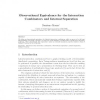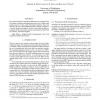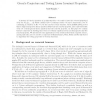103 search results - page 2 / 21 » A separation theorem in property testing |
ENTCS
2007
13 years 7 months ago
2007
We define an observational equivalence for Lafont’s interaction combinators, which we prove to be the least discriminating non-trivial congruence on total nets (nets admitting ...
ICASSP
2008
IEEE
14 years 1 months ago
2008
IEEE
The empirical mode decomposition (EMD) has seen widespread use for analysis of nonlinear and nonstationary time-series. Despite some practical success, it lacks a firm theoretica...
STOC
2009
ACM
14 years 2 months ago
2009
ACM
A system of linear equations in p unknowns Mx = b is said to have the removal property if every set S ⊆ {1, . . . , n} which contains o(np− ) solutions of Mx = b can be turned...
ENTCS
2008
13 years 7 months ago
2008
We present an extension to classical separation logic which allows reasoning about virtual memory. Our logic is formalised in the Isabelle/HOL theorem prover in a manner allowing ...
ISAAC
1992
Springer
13 years 11 months ago
1992
Springer
A (0,1)-matrix satisfies the consecutive ones property if there exists a column permutation such that the ones in each row of the resulting matrix are consecutive. Booth and Lueke...



